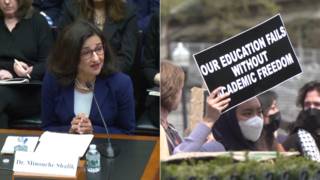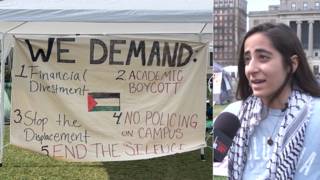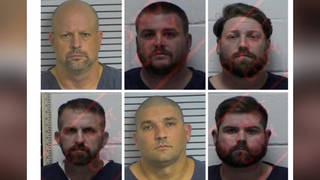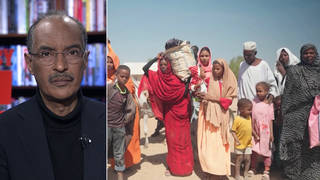
Related
Topics
Guinean immigrant Amadou Diallo, killed in a hail of 41 bullets last year by four white New York City police officers, was shot several times while falling down and after he was lying on the ground, a medical examiner testified yesterday in an Albany, New York courtroom. Dr. Joseph Cohen testified that one bullet went through the bottom of Diallo’s right shoe and came out of his toe. The officers, part of the city’s notorious Street Crimes Unit, are accused of second degree murder in the killing of Diallo, who was gunned down in the vestibule of his Bronx apartment building on Feb. 4, 1999. The unarmed black man was hit 19 times. [includes rush transcript]
Cohen, who performed the autopsy, described one wound to Diallo’s left leg and noted the “strikingly upward trajectory of the bullet,” suggesting Diallo was lying down or falling backward when the bullet was fired.
Cohen also described a wound that hit Diallo’s aorta, the main blood vessel to the heart, and a shot that paralyzed Diallo by going through his spine and caused him to fall. The pathologist also said tests found no traces of drugs or alcohol in Diallo’s body.
The prosecution wrapped up its presentation with damning testimony from another witness, Ida Vincent, a neighbor who said that after the shooting she heard someone outside her window saying “OK, OK we just want to say this.” This may indicate that the officers were trying to put together a story.
In addition, three other witnesses also testified that they heard a pause of several seconds between the first and second volley of shots, which the prosecution is contending would have given the officers enough time to determine whether Diallo posed a threat to them.
Today, the defense begins its presentation.
Tape:
- Report on the Diallo trial filed by Robert Knight, reporter for the news department of Pacifica’s WBAI in New York.
Guest:
- Roger Wareham, an attorney with the December 12th Movement.
Transcript
JUAN GONZALEZ: Now, we’re going to move to something closer to home: the continuing trial over the shooting death of Guinean immigrant Amadou Diallo, who was killed in a hail of forty-one bullets last year by four white New York City police officers. He was shot several times while falling down, according to the medical examiner’s testimony that was given yesterday. And Dr. Joseph Cohen testified that one bullet went through the bottom of Diallo’s right shoe and came out of his toe.
The officers, the four officers involved in the shooting, part of the city’s notorious Street Crimes Unit, are accused of second-degree murder in the killing of Diallo. He was gunned down in the vestibule of his Bronx apartment building on February 4, 1999. And of the forty-one bullets that the officers fired, Diallo was hit nineteen times.
Cohen, who performed the autopsy, described one wound to Diallo’s left leg and noted the “strikingly upward trajectory of the bullet” suggesting Diallo was lying down or falling backward when the bullet was fired.
Cohen also described a wound that hit Diallo’s aorta, the main blood vessel to the heart, and the shot that paralyzed — the same shot paralyzed Diallo by going through his spine and caused him to fall. The pathologist also said tests found no traces of drugs or alcohol in Diallo’s body.
The prosecution wrapped up its presentation yesterday with damning testimony from another witness, Ida Vincent, a neighbor who said that after the shooting she heard someone outside her window saying, “OK, OK, we just want to say this.” This may indicate that the officers were trying to put together a story.
In addition, three other witnesses also testified that they heard a pause of several seconds between the first and second volley of shots, which the prosecution is contending would have given the officers enough time to determine whether Diallo posed a threat to them.
Today, the defense begins its presentation, but we’re going to go to now to a report on the Diallo trial filed by Robert Knight, a reporter for the news department of Pacifica’s WBAI here in New York.
ROBERT KNIGHT: The prosecution case culminated Tuesday with the testimony of Bronx coroner Dr. Joseph Cohen, who explained in excruciating detail which of the nineteen bullets, of the forty-one fired, that actually hit Diallo, was the killing shot. According to Cohen, Amadou Diallo was killed by so-called bullet A, which hit him straight in the center chest, shattering his spine and causing nearly half of Diallo’s blood to drain into his chest cavity.
DR. JOSEPH COHEN: The other effect of gunshot wound A, by virtue of the spinal cord injury, is to cause rapid paraplegia. That is an inability to utilize voluntarily the lower extremities, from the hips to the knees, to the ankles. So that Mr. Diallo, after sustaining this injury, not only had a rapid drop in blood pressure and lack of profusion of his organs and tissues, but he also developed instantaneously an inability to support himself.
ROBERT KNIGHT: Therefore, Diallo would have been immediately immobilized and unable to stand. This means the remaining majority of shots sustained, mostly on his left side, with some hitting the bottom of his foot or tunneling up his leg, would have occurred after the victim was down, according to Cohen.
DR. JOSEPH COHEN: Most of the wounds had very little or no hemorrhage. Only a few had some hemorrhage that I quantitated as slight or slight to moderate. Most of the wounds had either no hemorrhage or very, very barely — barely perceptible hemorrhage or much less hemorrhage than I would expect.
ROBERT KNIGHT: In other words, they would of come after the killing and disabling shot A. A timeline for those shots was established in Monday’s testimony when three different neighborhood earwitnesses testified that they heard some shots, then a pause of a few seconds, followed by still more gunshots. First, Ida Vincent.
ATTORNEY: Will you please describe the pattern of the shots using your voice, using a particular word, and describe the pattern.
IDA VINCENT: Boom, boom. Boom, boom, boom, boom, boom, boom.
ATTORNEY: Could you demonstrate using your hands? Don’t say anything, just using your hands on the front of the railing there, the pattern of the shots.
IDA VINCENT: [Tap, tap, tap. Pause. Tap, tap, tap, tap, tap, tap.]
ATTORNEY: Could you tell how many shots there were before the pause?
IDA VINCENT: No.
ATTORNEY: Could you estimate how many shots there were after the pause?
IDA VINCENT: A lot more than the first.
ROBERT KNIGHT: That sequence was corroborated by witness Thomas Bell, currently a New York City Police Academy recruit.
ATTORNEY: Just using your hands on the table, and bang out the series of shots. The first shot, and then the gap, and then the second shot.
THOMAS BELL: Yes. [Tap, tap, tap, tap, tap. Pause. Numerous taps.]
ROBERT KNIGHT: The combined testimony represents a significant challenge to the scenario put forward by defense attorneys during opening arguments, that so many shots were fired because Diallo allegedly remained standing, pinned against the door, representing a perceived threat to the four Street Crimes Unit officers. Those questions were expected to be addressed Wednesday, when the defense was to begin arguing its case. For Democracy Now!, I’m Robert Knight.
JUAN GONZALEZ: And thanks to Robert Knight for that report. Robert Knight from the WBAI News Department. We’re going to take a break for sixty seconds, and then we’ll return with Robert Wareham, an attorney for the December 12th Movement, to discuss the Diallo trial.
[break]
JUAN GONZALEZ: You’re listening to Democracy Now!. I’m Juan Gonzalez. We’re joined now by Roger Wareham, an attorney with the December 12th Movement in New York City. And like many of us, he has been following closely the ongoing trial in Albany, because the judge in Albany, after the trial was moved by order of an appellate division court to Albany, the judge in Albany decided that it would — the trial would be aired over Court TV. So, many people in New York City and around the country have been able to watch the proceedings. Welcome to Democracy Now!, Roger.
ROGER WAREHAM: Good morning, Juan. Good morning, Amy.
JUAN GONZALEZ: Now, could you tell us what you’re reaction was to the testimony of the former medical examiner, Dr. Cohen, who is now a medical examiner in California, and how important that was to the prosecution’s case?
ROGER WAREHAM: I thought his testimony was very good. I think it was very important for the prosecution’s case, particularly around the issue of the paraplegia, because one of the defenses that have been put forward by the defendants’ attorneys has been that Amadou Diallo was standing upright, and therefore they continued to think he was a threat, because they claim that they thought he had a gun. And that defense had been put forward from the beginning, to the point where New York City, shortly after the shooting, had put forward a proposal to give the police department hollow-point bullets so that they would — bullets that would be more effective, that wouldn’t simply go through people, but would take them out much faster, ostensibly to deal with this issue of that it took so many bullets to bring this man down. So the fact that the medical examiner has demonstrated that he had — he no longer could support himself, that he was hitting the — that he was moving towards the ground after the first volley of bullets, is very, very important.
JUAN GONZALEZ: And, of course, in the cross-examination, the medical examiner was very firm in his judgment that the bullet that paralyzed him and also that severed or punctured the aorta, was one of the first bullets fired, right? So that they tried repeatedly to question his judgment on that issue.
ROGER WAREHAM: Right. They couldn’t shake him on that issue. And I think that was a very important point. So what they’re going to have to do in their defense is put forward an expert who will, I guess, testify that you can’t determine, or that the medical examiner couldn’t determine the exact order of bullets, so that what they’ll try and do is turn it on its head and say that the bullet that has been described as bullet A may have been bullet Z, and that that might have been the — and the last bullet to hit him, as opposed to the first bullet, because otherwise they’re sunk in terms of a very important tenet of their defense.
Another part of that is the whole question of the pause. I think that was crucial. I think the medical examiner’s testimony — excuse me — along with the consistent testimony of three independent witnesses that they heard a pause, was very important.
And I raise that — the national audience may not remember that there was a case in 1984, 1985, where an elderly black woman in the Bronx named Eleanor Bumpers was killed by a special team of New York City police, who went to basically effect an eviction of her from her apartment. And she was an elderly woman. She was sixty-four, sixty-five. And in this team, which had every conceivable means of dealing with people who are under emotional stress, didn’t use any of those things — the pepper spray, the Y-bar — but they ended up shooting her twice with a double — with a shotgun at close range, because they said that she threatened them by holding — she had a kitchen knife in her hand. This was a sixty-five-year-old woman who was tremendously overweight.
But the case came down to the question that when the prosecution, which is the Bronx, the same district attorney’s office as this prosecutor in the case now, but it was a different district attorney. The issue in that case came down to what was the period of time between the first shotgun blast and the second shotgun blast. And was there sufficient time between those blasts so that the police officer who killed, who shot her should of known that she was no longer a threat, because the district attorney’s office took the position in that case they conceded the first shot that — they conceded that he was — that he had a right — he was justified in shooting her the first time. But the question of the second time was that that was — she was no longer a threat, because, as it turned out from the medical examination, all she had left in her hand was — she had a piece of her thumb and a piece of her finger and a piece of the knife.
The problem in that prosecution was that the district attorney put forward that there was sufficient time between the two shots for him to know she was no longer a threat. But then the witnesses that they put on to prove their case contradicted their theory of the case. You had witnesses who said they were wildly different amounts of time, so that they really undercut — you know, they went through the façade of the case, they undercut their own case. The difference at this point in this trial is that the prosecution’s case seems consistent. It seems to be building on itself to make a — to really be an effective prosecution.
The real test is going to be not so much on the prosecution’s case, which has now come to an end, but what will be the nature of their rebuttal case after the defense puts on their justification, their defense of justification that the officers really thought there was a threat, they really legitimately believed that, and if you put themselves in their place you would have done the same thing. What will be the nature of the prosecution’s rebuttal? So this trial is not over yet, even though it looks positive at this point in terms of the prosecution having presented an effective prosecution.
JUAN GONZALEZ: And, of course, the — we have been prepared by leaks from the defense lawyers of the officers that one of the defenses that they will use, especially in terms of the pause, is that one of the officers, after firing some bullets, slipped and fell. And as a result, the other officers were under the impression that he had been hit and that they conceivably are going to look at the whole issue of bullets that ricocheted out of the vestibule and back at the officers. And it seems that one of the — one thing that is on their side on that is that there was at least one bullet that was recovered across the street from the shooting, which might indicate that the bullet ricocheted from the building all the way across the street. Is that right, Roger?
ROGER WAREHAM: I believe that that’s true. Certainly, bullets ricocheted, but I think they’re really grasping at straws, which is why the medical examiner’s testimony becomes crucial. If they’re taking the position that — if the defense takes the position that there was sufficient light for them to see that he had something in his hand, but now they’re going to take the position that there was insufficient light to know that he had hit the ground. And, see, that’s why the testimony yesterday was crucial, because the medical examiner has established that after the first few shots Amadou Diallo had hit the ground. And if they’re going to maintain, well, they thought they were being shot at, they are going to have to say they didn’t see him on the ground and that he was being — now he was shooting from a prone position on his back, because it was clear that he had been, from the testimony yesterday, that he was shot in the foot, so he was lying there on his back with his head away from them. So they have — you know, what looks like it might be a good defense for them becomes a real problem because of the medical examiner’s testimony.
JUAN GONZALEZ: Could you talk a little bit about the big blunder that the defense made earlier this week with one witness, Ida Vincent?
ROGER WAREHAM: Right. Ida Vincent was a woman who lived in the next building, I believe, who was going to testify. The prosecution was going to let her testify, wanted her to testify, that not only — after the firing that she heard two of the cops — she didn’t know who — or two men saying, “OK, OK, this is what we’re going to say,” something to that effect, in terms of what, I guess, an objective observer would sum up, what was going to be their cover-up in terms of how we’re going to clean this up. And those of us who’ve been in this struggle in New York for so many years know that they — that’s the standard operating procedure of the police department.
JUAN GONZALEZ: Roger, I want to interrupt you here, because the testimony is starting, and we just want to listen in a little bit —
ROGER WAREHAM: Sure.
JUAN GONZALEZ: — to the first defense witness, a person — a man by the name of Peter Shumacher.
SGT. PETER SCHUMACHER: For the first ten years, I was a New York City housing police office. Then the departments merged and —
ATTORNEY: What is the housing police?
SGT. PETER SCHUMACHER: It was basically just like the New York City Police Department, but it was its own department. We worked in the housing developments.
ATTORNEY: OK. And after those ten years, where did you work?
SGT. PETER SCHUMACHER: We merged with NYPD. I stayed in the Housing Bureau a little while, then I went to Narcotics Division, then I went to the Bronx as a patrol sergeant after I got promoted, and then I went to Internal Affairs Bureau.
ATTORNEY: Where are you assigned now?
SGT. PETER SCHUMACHER: Internal Affairs Bureau.
ATTORNEY: And what does the Internal Affairs Bureau do, sir?
SGT. PETER SCHUMACHER: We do — any allegation or complaint of criminal wrongdoing by police officers or misconduct, we investigate those allegations or complaints.
JUAN GONZALEZ: We’re listening to the first defense witness for the four officers accused of second-degree murder in the shooting of Amadou Diallo. It’s Sergeant Peter Schumacher of the New York City Police Department.
ATTORNEY: And where were you assigned on February 4th, 1999?
SGT. PETER SCHUMACHER: Internal Affairs Bureau.
ATTORNEY: What was your rank then?
SGT. PETER SCHUMACHER: Sergeant.
ATTORNEY: And by the way, have you ever made any felony arrests?
SGT. PETER SCHUMACHER: Felony arrests? Yes.
ATTORNEY: How many, you think, ballpark?
SGT. PETER SCHUMACHER: Well, I’d say well over a hundred.
ATTORNEY: On February 4, 1999, who was your supervisor?
SGT. PETER SCHUMACHER: That night in the field, it was Lieutenant Gates and Captain Pascasio.
ATTORNEY: And who is your supervisor now?
SGT. PETER SCHUMACHER: Right now it’s Lieutenant Morrissey is my group leader, and Captain DeFranco and Inspector Gilmartin.
ATTORNEY: By the way, do you know any of the four young men on trial here?
SGT. PETER SCHUMACHER: No, I do not.
ATTORNEY: Have you ever spoken to them?
SGT. PETER SCHUMACHER: No, I did not.
ATTORNEY: Have you ever met them anywhere?
SGT. PETER SCHUMACHER: No.
ATTORNEY: I want to direct your attention to the evening of February 4, 1999. Do you remember where you were?
SGT. PETER SCHUMACHER: Yes, I do.
ATTORNEY: And where were you that evening?
SGT. PETER SCHUMACHER: That evening, I was — about 9:00 we left the office, and we were assigned to do a canvass on Wheeler Street, where the — or Wheeler Avenue, where the shooting occurred the night before.
ATTORNEY: Why were you doing that?
SGT. PETER SCHUMACHER: We were canvassing the area for witnesses.
ATTORNEY: Now, that night, who were you with? Police officers, I’m speaking of.
SGT. PETER SCHUMACHER: That night I was with Sergeant Keelan and Lieutenant Gates. Us three were assigned as basically a team.
ATTORNEY: Is that the Lieutenant Gates who was your supervisor that night?
SGT. PETER SCHUMACHER: Yes.
ATTORNEY: Did you have a conversation with an individual named Debbie Rivera?
SGT. PETER SCHUMACHER: Yes, I did.
ATTORNEY: Do you remember where you had that conversation?
SGT. PETER SCHUMACHER: It was in the —- I don’t remember the exact address [inaudible] -—
JUAN GONZALEZ: This Debbie Rivera, for those of you who have not been following the trial, was one of the first witnesses for the prosecution, who said that she heard a pause in the shots that occurred across the street from her home and saw the police officers shortly before and shortly after the shooting through her window.
ATTORNEY: Take a look at it. Hold onto it. See if it helps you remember or refreshes your recollection, sir.
SGT. PETER SCHUMACHER: Ms. Rivera was at 1162 Wheeler Avenue, Apartment 2-Frank.
ATTORNEY: And where did you speak to her?
SGT. PETER SCHUMACHER: We — I knocked on —- I knocked on the door -—
ATTORNEY: Who was with you?
SGT. PETER SCHUMACHER: Sergeant Keelan and Lieutenant Gates.
ATTORNEY: And, by the way, how were you dressed?
SGT. PETER SCHUMACHER: Sport jacket, shirt, tie.
ATTORNEY: And did you have a badge?
SGT. PETER SCHUMACHER: Yes, I did.
ATTORNEY: Where was that badge?
SGT. PETER SCHUMACHER: I hold it in my hand, and I put it up to the peephole, or when they — when they answer the door, I show my badge to them.
ATTORNEY: Now, did you make notes of that conservation?
SGT. PETER SCHUMACHER: Yes, I did.
ATTORNEY: And with those notes, did you prepare a report later on?
SGT. PETER SCHUMACHER: Yes.
ATTORNEY: And was that report shown to anybody else?
SGT. PETER SCHUMACHER: It was given to my lieutenant at the end of the night.
ATTORNEY: Which lieutenant?
SGT. PETER SCHUMACHER: Lieutenant Gates.
ATTORNEY: Was he present during the interview?
SGT. PETER SCHUMACHER: Yeah, I believe he was, yes.
ATTORNEY: OK. And on your reports, do you try and make them as accurate as possible?
SGT. PETER SCHUMACHER: Yes.
ATTORNEY: OK.
JUAN GONZALEZ: Well, Roger, clearly what the — there’s a break here, unfortunately, in the Court TV broadcast for commercials. But the situation here, obviously, is that the prosecution is trying to discredit witness Debbie Rivera. And for those who have been following the trial, they remember that she made clear that she was not forthcoming with the first police that came to her door, because once she knew that it was a police officer who had been involved in the shooting, she did not trust other police who came to her house to give them information as to what she had seen. Now, maybe for some of the jurors up in Albany, that might seem suspicious, but, Roger, what’s your reaction when you heard her say that?
ROGER WAREHAM: Right. My reaction is that living in New York, having been in New York my entire life and seeing over a half a century what — not only what the police have done in terms of killing people, but what the cover-up has been, that would be a justifiable reaction.
There was a case three years ago, four years ago, where some young man named Aswan Watson was killed by the same street crimes unit that these officers were part of in Brooklyn in broad daylight with witnesses all over the street. He was shot twenty-four times. He was unarmed, he was not retreating. And after a grand jury investigation, they found that no crime had been committed. And the Brooklyn district attorney summed up that they had followed proper police procedure. So that’s the context within which people in New York City, particularly from the black and Latino community, approach the police investigating themselves. You know, it’s the fox in the chicken coop.
So that’s an understandable reaction, and that’s really one of the problems with changing this case from a venue from New York City to the Bronx — I mean, to Albany, where people won’t have the same perspective, and they may think that this was a question of duplicity or dishonesty on her part, as opposed to a real question of caution and wanting to hold up speaking ’til she got to someone who she could really trust.
JUAN GONZALEZ: Of course, and then there was the Anthony Baez case, where one officer, eventually in a federal trial, the choking death of Anthony Baez, testified that the other officers who were at the scene conspired to set their stories all straight in the precinct parking lot to basically cover up the choking death of Anthony Baez.
ROGER WAREHAM: Right, and that’s endemic to New York, because New York has a rule where officers do not have to testify for — it’s either forty-eight or ninety-six hours after an event. They don’t have to talk to anybody, even their internal affairs people. So it gives them time to put together the story, the cover-up story, so it’s really built into the regulations of New York City that the police are given an opportunity to work a cover-up.
JUAN GONZALEZ: Roger, I’m going have to cut you off, because we’re out of time. I want to thank you for being with us. Roger Wareham, an attorney with the December 12th Movement.












Media Options